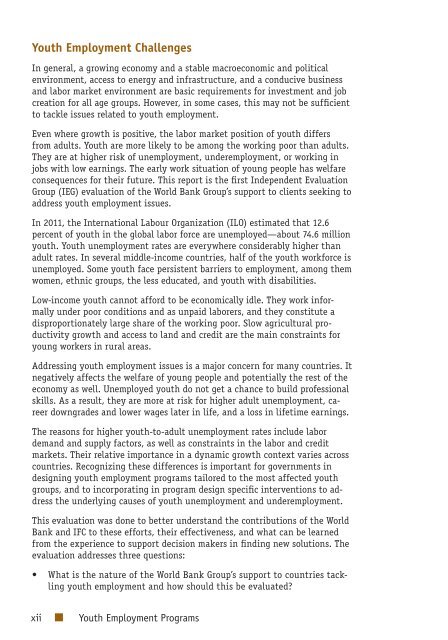Youth Employment Programs - Independent Evaluation Group
Youth Employment Programs - Independent Evaluation Group
Youth Employment Programs - Independent Evaluation Group
Create successful ePaper yourself
Turn your PDF publications into a flip-book with our unique Google optimized e-Paper software.
<strong>Youth</strong> <strong>Employment</strong> ChallengesIn general, a growing economy and a stable macroeconomic and politicalenvironment, access to energy and infrastructure, and a conducive businessand labor market environment are basic requirements for investment and jobcreation for all age groups. However, in some cases, this may not be sufficientto tackle issues related to youth employment.Even where growth is positive, the labor market position of youth differsfrom adults. <strong>Youth</strong> are more likely to be among the working poor than adults.They are at higher risk of unemployment, underemployment, or working injobs with low earnings. The early work situation of young people has welfareconsequences for their future. This report is the first <strong>Independent</strong> <strong>Evaluation</strong><strong>Group</strong> (IEG) evaluation of the World Bank <strong>Group</strong>’s support to clients seeking toaddress youth employment issues.In 2011, the International Labour Organization (ILO) estimated that 12.6percent of youth in the global labor force are unemployed—about 74.6 millionyouth. <strong>Youth</strong> unemployment rates are everywhere considerably higher thanadult rates. In several middle-income countries, half of the youth workforce isunemployed. Some youth face persistent barriers to employment, among themwomen, ethnic groups, the less educated, and youth with disabilities.Low-income youth cannot afford to be economically idle. They work informallyunder poor conditions and as unpaid laborers, and they constitute adisproportionately large share of the working poor. Slow agricultural productivitygrowth and access to land and credit are the main constraints foryoung workers in rural areas.Addressing youth employment issues is a major concern for many countries. Itnegatively affects the welfare of young people and potentially the rest of theeconomy as well. Unemployed youth do not get a chance to build professionalskills. As a result, they are more at risk for higher adult unemployment, careerdowngrades and lower wages later in life, and a loss in lifetime earnings.The reasons for higher youth-to-adult unemployment rates include labordemand and supply factors, as well as constraints in the labor and creditmarkets. Their relative importance in a dynamic growth context varies acrosscountries. Recognizing these differences is important for governments indesigning youth employment programs tailored to the most affected youthgroups, and to incorporating in program design specific interventions to addressthe underlying causes of youth unemployment and underemployment.This evaluation was done to better understand the contributions of the WorldBank and IFC to these efforts, their effectiveness, and what can be learnedfrom the experience to support decision makers in finding new solutions. Theevaluation addresses three questions:• What is the nature of the World Bank <strong>Group</strong>’s support to countries tacklingyouth employment and how should this be evaluated?xii<strong>Youth</strong> <strong>Employment</strong> <strong>Programs</strong>
















